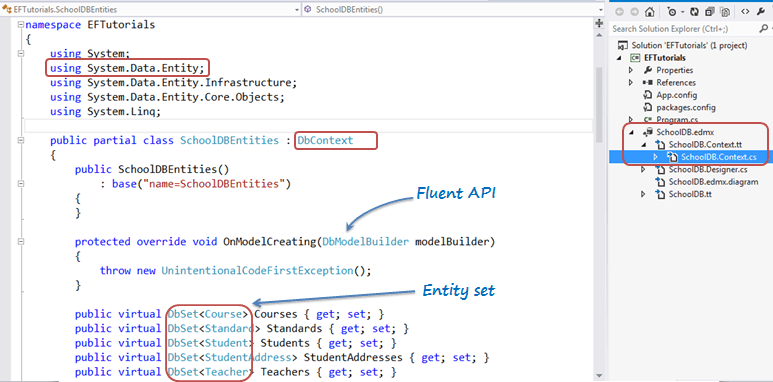DbContext Class in Entity Framework 6 DB-First Approach
As you have seen in the previous Create Entity Data Model section, EDM includes the SchoolDBEntities class, which is derived from the System.Data.Entity.DbContext class, as shown below.
The class that derives DbContext is called the context class in Entity Framework.

DbContext is an important class in Entity Framework API. It is a bridge between your domain or entity classes and the database.

DbContext is the primary class that is responsible for interacting with the database. It is responsible for the following activities:
- Querying: Converts LINQ-to-Entities queries to SQL queries and sends them to the database.
- Change Tracking: Keeps track of changes that occurred on the entities after querying from the database.
- Persisting Data: Performs the Insert, Update and Delete operations to the database, based on entity states.
- Caching: Provides first level caching by default. It stores the entities which have been retrieved during the lifetime of a context class.
- Manage Relationships: Manages relationships using CSDL, MSL and SSDL in Db-First or Model-First approach, and using fluent API configurations in Code-First approach.
- Object Materialization: Converts raw data from the database into entity objects.
The following is an example of SchoolDBEntities class (context class that derives from DbContext) generated with EDM for the SchoolDB database in the previous section.
namespace EFTutorials { using System; using System.Data.Entity; using System.Data.Entity.Infrastructure; using System.Data.Entity.Core.Objects; using System.Linq; public partial class SchoolDBEntities : DbContext { public SchoolDBEntities() : base("name=SchoolDBEntities") { } protected override void OnModelCreating(DbModelBuilder modelBuilder) { throw new UnintentionalCodeFirstException(); } public virtual DbSet<Course> Courses { get; set; } public virtual DbSet<Standard> Standards { get; set; } public virtual DbSet<Student> Students { get; set; } public virtual DbSet<StudentAddress> StudentAddresses { get; set; } public virtual DbSet<Teacher> Teachers { get; set; } public virtual DbSet<View_StudentCourse> View_StudentCourse { get; set; } public virtual ObjectResult<GetCoursesByStudentId_Result> GetCoursesByStudentId(Nullable<int> studentId) { var studentIdParameter = studentId.HasValue ? new ObjectParameter("StudentId", studentId) : new ObjectParameter("StudentId", typeof(int)); return ((IObjectContextAdapter)this).ObjectContext.ExecuteFunction<GetCoursesByStudentId_Result>("GetCoursesByStudentId", studentIdParameter); } public virtual int sp_DeleteStudent(Nullable<int> studentId) { var studentIdParameter = studentId.HasValue ? new ObjectParameter("StudentId", studentId) : new ObjectParameter("StudentId", typeof(int)); return ((IObjectContextAdapter)this).ObjectContext.ExecuteFunction("sp_DeleteStudent", studentIdParameter); } public virtual ObjectResult<Nullable<decimal>> sp_InsertStudentInfo(Nullable<int> standardId, string studentName) { var standardIdParameter = standardId.HasValue ? new ObjectParameter("StandardId", standardId) : new ObjectParameter("StandardId", typeof(int)); var studentNameParameter = studentName != null ? new ObjectParameter("StudentName", studentName) : new ObjectParameter("StudentName", typeof(string)); return ((IObjectContextAdapter)this).ObjectContext.ExecuteFunction<Nullable<decimal>>("sp_InsertStudentInfo", standardIdParameter, studentNameParameter); } public virtual int sp_UpdateStudent(Nullable<int> studentId, Nullable<int> standardId, string studentName) { var studentIdParameter = studentId.HasValue ? new ObjectParameter("StudentId", studentId) : new ObjectParameter("StudentId", typeof(int)); var standardIdParameter = standardId.HasValue ? new ObjectParameter("StandardId", standardId) : new ObjectParameter("StandardId", typeof(int)); var studentNameParameter = studentName != null ? new ObjectParameter("StudentName", studentName) : new ObjectParameter("StudentName", typeof(string)); return ((IObjectContextAdapter)this).ObjectContext.ExecuteFunction("sp_UpdateStudent", studentIdParameter, standardIdParameter, studentNameParameter); } } }
As you can see in the above example, the context class (SchoolDBEntities) includes the entity set of type DbSet<TEntity> for all the entities.
Learn about DbSet class here. It also includes functions for the stored procedures and views included in EDM.
The OnModelCreating method allows us to configure the model using DbModelBuilder Fluent API in EF 6.
DbContext Methods
| Method | Usage |
|---|---|
| Entry |
Gets an DbEntityEntry for the given entity. The entry provides access to change tracking information and operations for the entity.
|
| SaveChanges | Executes INSERT, UPDATE, and DELETE commands to the database for the entities with Added, Modified, and Deleted states. |
| SaveChangesAsync | Asynchronous method of SaveChanges() |
| Set | Creates a DbSet<TEntity> that can be used to query and save instances of TEntity. |
| OnModelCreating | Override this method to further configure the model that was discovered by convention from the entity types exposed in DbSet<TEntity> properties on your derived context. |
DbContext Properties
| Method | Usage |
|---|---|
| ChangeTracker | Provides access to information and operations for entity instances that this context is tracking. |
| Configuration | Provides access to configuration options. |
| Database | Provides access to database-related information and operations. |